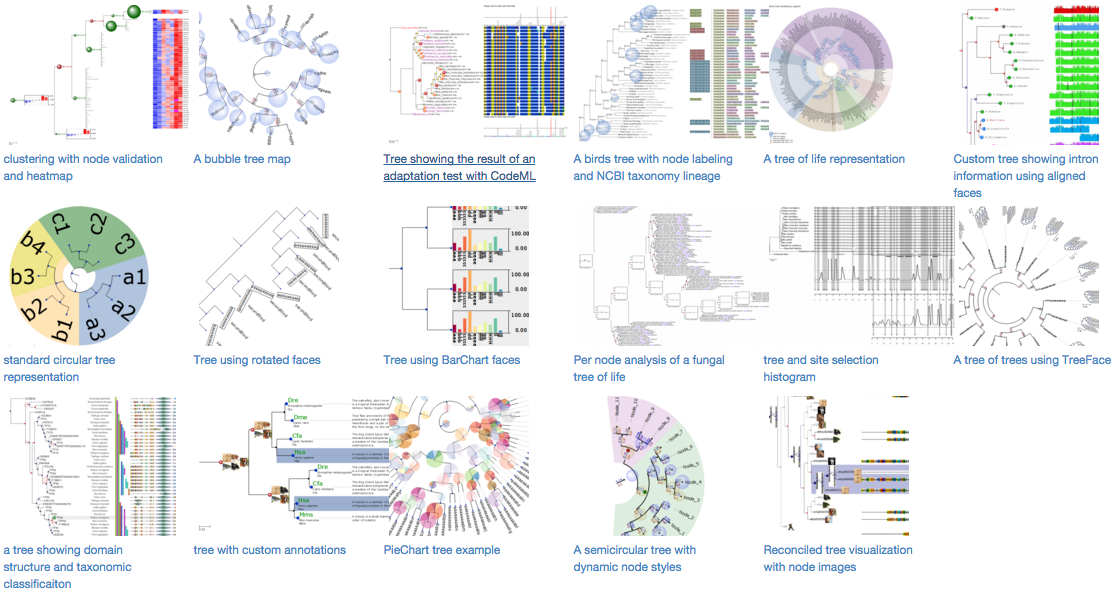This repository is a clone of ete
with only the branches ete4, ete3, 3.0, and 2.3, which has
been cleaned up from old big blobs to reduce its size (from 140 MB in
a fresh install to just 30 MB).
For the moment it is just a proof of concept. It may or may not be updated with the latest content in the main repository.
We created it by cloning the original repository, removing branches
with git branch -D ..., and then:
git filter-repo --strip-blobs-bigger-than 1Mand edit .git/config to re-add:
[remote "origin"]
url = [email protected]:etetoolkit/ete.git
fetch = +refs/heads/*:refs/remotes/origin/*
and finally:
git push --force --mirror originThen, the updates are done from the original repository with a
combination of git format-patch and git apply.
ETE (Environment for Tree Exploration) is a toolkit that assists in the automated manipulation, analysis and visualization of trees. It is mainly written in Python, and includes many extra functionalities for phylogenetic trees.
Its main features include:
- Read and write support for trees in Newick format
- Multiple functions for traversing, searching and manipulating tree topologies and node annotations
- Integration with NCBI Taxonomic database
- Integration with GTDB database
- Programmatic visualization framework
- Visualization of huge trees based on adaptive zooming
- Comparing trees
- Phylogenetic functions
- orthology detection
- phylogenetic distance
- Command line tools
- phylogenetic reconstruction protocols
- tree comparison
- tree diff
The official website of ETE is http://etetoolkit.org. You can find downloading instructions and further documentation there.
If you use ETE, please cite:
Jaime Huerta-Cepas, François Serra and Peer Bork. "ETE 3: Reconstruction,
analysis and visualization of phylogenomic data." Mol Biol Evol (2016) doi:
10.1093/molbev/msw046
pip install https://github.com/etetoolkit/ete/archive/ete4.zipTo install ETE in a local directory to help with the development, you can:
- Clone this repository (
git clone https://github.com/etetoolkit/ete.git) - Install dependecies
- If you are using conda:
conda install -c conda-forge cython bottle brotli numpy scipy - Otherwise, you can install them with
pip install <dependencies>
- If you are using conda:
- Build and install ete4 from the repository's root directory:
pip install -e .
If you want to use the treeview module (which depends on
PyQt), you can
add [treeview] to the pip installation.
For example with pip install -e .[treeview] for a local editable
installation. Or pip install -e .[treeview,test,doc] to also include
the modules for testing and generating the documentation.
To simply load a tree from a file (my_tree.nw) and start exploring
it interactively, you can use the ete4 utility and run:
ete4 explore -t my_tree.nwOr start a python session and write:
from ete4 import Tree
t = Tree(open('my_tree.nw'))
t.explore()It will open a browser window with an interface to explore the tree.
Most documentation is automatically generated with
sphinx from the contents of the doc
directory, and is available at https://etetoolkit.github.io/ete/ .
Rather than sending direct support-related emails to the developers, it is better to keep the communication public.
For question on how to use ETE in the bioinformatics context, use
Biostars with the etetoolkit tag, or stack
overflow.
For bug reports, feature requests and general discussion, use https://github.com/etetoolkit/ete/issues
For more technical problems, you can also use the official ETE mailing list at https://groups.google.com/d/forum/etetoolkit. To avoid spam, messages from new users are moderated. Expect some delay until your first message appears after your account is validated.
For any other inquiries (collaborations, sponsoring, etc), please contact [email protected].
You can launch some tests by running:
./run_tests.py



